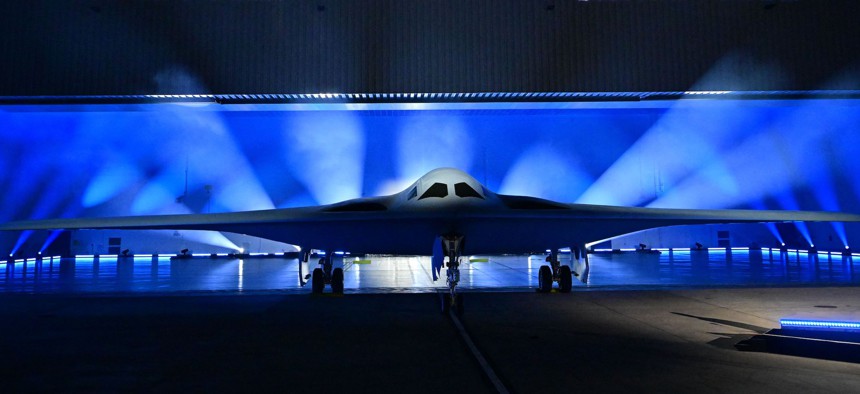
The B-21 Raider is unveiled during a ceremony at Northrop Grumman's Air Force Plant 42 in Palmdale, California, on December 2, 2022. FREDERIC J. BROWN/AFP via Getty Images
Air Force Should Double Its B-21 Purchase Plans, Think Tank Says
The service also needs to buy the stealth bombers more quickly, a new Mitchell Institute report says.
A prominent airpower think tank says the U.S. Air Force must more than double its planned purchase of a minimum of 100 B-21 bombers if it is to win a war against China.
A total of more than 300 bombers would be needed, including 225 of the recently unveiled B-21 plus several dozen B-1s and B-52s, said Mark Gunzinger, a retired Air Force colonel who leads future concepts and capability assessments at the Mitchell Institute for Aerospace Studies, part of the Air & Space Forces Association industry group.
As well, planned production of B-21s should be sped up to 20 per year from the planned eight or nine, Gunzinger told reporters on Thursday ahead of the rollout of a new Mitchell Institute report on the topic.
“More resources can buy back future risk and that's what a more aggressive acquisition rate for the B-21 can do,” Gunzinger said.
The report says the Air Force lacks enough aircraft with the range, payload, and stealth to fight China. It also asserts that declining to double B-21 production will cost more than the planes’ purchase price.
“Throttling B-21 acquisition during this critical period will increase the risk of a conflict with an opportunistic China that would result in costs that exceed any temporary program savings,” it said.
Out of the service’s $185.1 billion 2024 spending request, nearly $3 billion will go to the B-21 program. Service officials said the budget procures “more than one” B-21, but declined to say the exact number.
Buying sufficient B-21s “will require avoiding the same kind of budget-driven decisions that eroded nearly all the service’s advanced combat aircraft purchases since the Cold War, as in the case of the B-2, the F-22, and now the F-35A,” the report said.
The Air Force had intended to buy more than 100 B-2s, but only ended up buying 21 of the $2 billion-a-copy stealth bombers.
The B-21 is part of the Air Force’s current effort to replace most of its nuclear delivery weapons, including its ICBMs.
Unveiled in December, the B-21 is expected to make its first flight later this year. While the schedule has slipped “by a few months,” it remains within the program’s “baseline schedule,” Air Force Secretary Frank Kendall said on Wednesday at the annual McAleese and Associates Defense Programs conference.
“I hope we can hold that schedule,” Kendall said.




